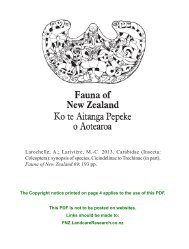Fauna of NZ 45 - Landcare Research
Fauna of NZ 45 - Landcare Research
Fauna of NZ 45 - Landcare Research
Create successful ePaper yourself
Turn your PDF publications into a flip-book with our unique Google optimized e-Paper software.
<strong>Fauna</strong> <strong>of</strong> New Zealand <strong>45</strong> 17<br />
KEY TO FAMILIES OF ADULT NEW ZEALAND<br />
CURCULIONOIDEA<br />
1 Antennae straight (orthocerous, non-elbowed), funicle<br />
following direction <strong>of</strong> scape (Fig. 1), if elbowed, or<br />
subgeniculate as in Fig. 10, then trochanters elongate,<br />
separating femora from coxae .................................. 2<br />
—Antennae elbowed (geniculate, gonatocerous), funicle<br />
deflected from direction <strong>of</strong> scape in an angle (Fig. 181),<br />
trochanters short, not separating femora from coxae<br />
.......................................................... Curculionidae<br />
2(1) Labrum free, distinct, separated from clypeus by a<br />
distinct suture (Fig. 19–26) ..................................... 3<br />
—Labrum not distinct, fused with clypeus (Fig. 175, 176)<br />
................................................................................. 4<br />
3(2)Labrum finely braced to clypeus, separated by a fine<br />
suture (Fig. 173). Prothorax lacking a transverse carina.<br />
Elytral puncta lined up to form perfect striae (Fig. 2).<br />
All tibiae having spurs ..... (p. 17) ... Nemonychidae<br />
—Labrum loosely articulated to clypeus, separated by a<br />
deep, manifest suture (Fig. 174). Prothorax usually<br />
with a transverse carina. Elytral puncta not lined up<br />
into distinct striae. All tibiae lacking spurs ...............<br />
....... (<strong>Fauna</strong> N.Z. 3, Holloway 1982) ... Anthribidae<br />
4(2)Fore tibia with a grooming device on inner face opposite<br />
tarsal insertion, consisting <strong>of</strong> dense, fine vestiture in a<br />
broad groove or impression (Fig. 183, 184). Gular<br />
suture double or absent. Elytra irregularly punctate; if<br />
puncta arranged into striae, then a scutellar striole<br />
distinct. Abdomen in lateral view having all ventrites at<br />
same level ..................................... (p. 21) ... Belidae<br />
—Fore tibia lacking a grooming device on inner face opposite<br />
tarsal insertion (Fig. 182). Gular suture single, distinct.<br />
Elytra distinctly striate, always lacking a scutellar<br />
striole. Abdomen in lateral view having ventrites 1 and<br />
2 deeper down than 3 to 5 ....... (p. 31) ... Brentidae<br />
DESCRIPTIONS<br />
Family NEMONYCHIDAE<br />
The family Nemonychidae in New Zealand is represented<br />
solely by the genus Rhinorhynchus which comprises four<br />
species associated with Podocarpaceae and Phyllocladaceae.<br />
All four species are found on the same wide range <strong>of</strong> hosts<br />
and obtained, occasionally, concurrently on the same shrub<br />
or tree. Rhinorhynchus is the type genus <strong>of</strong> the subfamily<br />
Rhinorhynchinae, to which all the southern hemisphere<br />
Nemonychidae belong, as well as a few species from Central<br />
America and the United States.<br />
Genus Rhinorhynchus Sharp<br />
Fig. 1, 2, 19–26<br />
Sharp, 1882: 88 (type-species R. zealandicus Sharp<br />
[=Rhinomacer rufulus Broun, 1880]). —Voss, 1922: 17,<br />
19; 1932: 101, 106. —Crowson, 1953: 240, 242; 1955:<br />
158. —Kuschel, 1959: 237. —May, 1993: 27 (larva).<br />
Listrorhinus Voss, 1922: 9, 13 (as subg. <strong>of</strong> Rhinomacer; typespecies<br />
Rhinomacer rufulus Broun, 1880)); 1931: 164;<br />
1932: 72.<br />
Head weakly to distinctly constricted a short distance behind<br />
eyes. Frons anteriorly twice as wide as rostrum across<br />
antennal insertions, or wider. Eyes in lateral view round,<br />
with moderately coarse ommatidia. Rostrum moderately<br />
long, in male a little shorter than prothorax, in female slightly<br />
longer than prothorax; scrobes indistinct, shallow, lacking<br />
a defined dorsal edge; pubescence on basal part directed<br />
basad. Antennae distant from mandibular sockets by twice<br />
width <strong>of</strong> scape or more; segment 1 (scape) thin, not distinctly<br />
thicker than segment 2, a little compressed especially<br />
in female; segment 2 slightly thicker and distinctly<br />
longer than 3. Labrum as in Fig. 27, small, sinuously triangular,<br />
broader in male, with four short peg-like setae at<br />
apex and two pairs <strong>of</strong> setiferous puncta on dorsal surface.<br />
Mandibles as in Fig. 28, slender, long, falciform, unarmed,<br />
lacking a dorsolateral groove, with a row <strong>of</strong> fine punctation<br />
instead, ending with a long seta. Maxillary palpi (Fig. 28)<br />
short, flexible, with segments loosely articulated; segments<br />
2 and 3 subequal, 4 as long as other three combined.<br />
Postmentum broad, with lateroapical angles rounded.<br />
Prothorax relatively longer in male, weakly impressed<br />
on either side <strong>of</strong> midline near base. Elytra distinctly,<br />
regularly striate, with supernumerary puncta on interstria<br />
10 alongside metasternum. Hind wing (Fig. <strong>45</strong>) fully<br />
developed; anal veins weakly sclerotised.<br />
Front coxae subconical, much closer to base than apex<br />
<strong>of</strong> prothorax. Front and middle tibiae with rather sharp<br />
dorsal edge (less distinct in R. rufulus); all tibiae with 2<br />
spurs in both sexes, in male incurved near apex and distinctly<br />
mucronate. Claws (Fig. 30) with dentiform appendix.
















